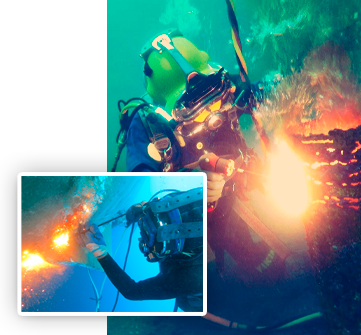A Comparison of Different Underwater Inspection Methods: Why UESI’s Technology Stands Out
In industries such as marine construction, oil and gas exploration, and infrastructure maintenance, underwater inspections play a crucial role in ensuring the integrity and safety of submerged structures. From offshore platforms to underwater pipelines, these inspections provide vital information about the condition of assets and help identify potential issues before they escalate into costly problems. Learn the various methods for underwater inspection, including remote underwater inspection, and highlight why Underwater Engineering Services Inc. (UESI) stands out as a leader in the field.

Understanding Underwater Inspection Methods
Diver-Based Inspection:
Diver-based inspection is one of the traditional methods for underwater assessment. It involves sending trained divers equipped with specialized equipment to inspect submerged structures visually. Divers use underwater cameras, lights, and other tools to capture images and videos of the underwater environment. While diver-based inspections offer a high level of detail and flexibility, they can be limited by factors such as visibility and accessibility.
Remotely Operated Vehicles (ROVs):
ROVs are unmanned underwater vehicles with cameras, sensors, and manipulator arms. They are controlled remotely from the surface and can access areas that may be too deep or hazardous for divers. ROVs provide real-time video footage and data, allowing inspectors to assess underwater structures without requiring direct human intervention. ROVs are particularly useful for inspections in challenging environments or hazardous conditions.
Autonomous Underwater Vehicles (AUVs):
AUVs are self-propelled, unmanned vehicles designed to operate autonomously underwater. Unlike ROVs tethered to a surface vessel, AUVs navigate independently and collect data using onboard sensors and cameras. AUVs are well-suited for large-scale surveys and mapping projects, as they can cover large areas efficiently and collect high-resolution data for detailed analysis.
Sonar Imaging:
Sonar imaging utilizes sound waves to create detailed images of underwater structures. Sonar systems emit acoustic signals that bounce off submerged objects and return to a receiver, producing a visual representation of the underwater environment. Sonar imaging is particularly effective in low-visibility conditions and can provide valuable insights into underwater topography and the condition of submerged assets.
Remote Underwater Inspection Systems (RUIS)
Remote underwater inspection systems combine ROVs, AUVs, and sonar imaging elements to provide comprehensive underwater assessments. These systems have advanced sensors, cameras, and navigation capabilities, allowing inspectors to conduct detailed inspections from the surface or a remote location. RUIS offers the advantages of real-time data collection, high-resolution imaging, and remote operation, making them ideal for a wide range of underwater inspection applications.
Why UESI’s Technology Stands Out
As a leading commercial diving, civil marine contractor, and specialty engineering company operating worldwide, Underwater Engineering Services Inc. (UESI) leverages cutting-edge technology and industry expertise to deliver exceptional underwater inspection services. Here’s why UESI’s technology stands out:
Comprehensive Services: UESI provides a comprehensive range of underwater inspection, maintenance, repair, construction, and technical support services to customers worldwide. Their services are designed to suit the needs of specific industries, including oil and gas, marine construction, and infrastructure maintenance.
Highly Qualified Inspectors and Technicians: UESI employs highly qualified inspectors and technicians who undergo specialized training in underwater inspection techniques and safety protocols. Their expertise ensures that inspections are conducted precisely and accurately, yielding reliable results that inform maintenance and repair decisions.
Site-Specific Procedures: UESI develops site-specific procedures and innovative practices tailored to each project’s unique requirements. By considering factors such as environmental conditions, structural complexity, and regulatory compliance, UESI ensures that inspections are relevant and effective in identifying potential issues and mitigating risks.
Specialized Training and Diving Techniques: UESI’s approach combines knowledge of industry requirements with specialized training and diving techniques to ensure inspections are conducted safely and efficiently. Their team of experienced divers and technicians utilizes state-of-the-art equipment and methods to navigate underwater environments and collect accurate data.
Customer-Centric Approach: UESI prioritizes customer satisfaction and strives to exceed expectations with every project. Their team works closely with clients to understand their needs, goals, and challenges, providing personalized solutions that address their specific requirements and objectives.
Underwater inspections are critical for assessing the condition and integrity of submerged structures in various industries. With advanced technology, specialized expertise, and a customer-centric approach, Underwater Engineering Services Inc. (UESI) stands out as a leader in the field, delivering comprehensive underwater inspection services that meet the needs of their clients worldwide. Whether it’s diver-based inspections, ROVs, AUVs, sonar imaging, or remote underwater inspection systems, UESI leverages a diverse range of methods and technologies to ensure accurate and reliable assessments of underwater assets.
Phone: 772-337-3116
Email: bbegano@uesi.com / aconnelly@uesi.com
Address: 4950 Genesee Street, Suite 100, Buffalo, New York 14225

